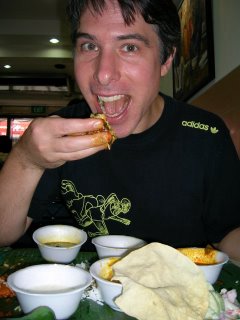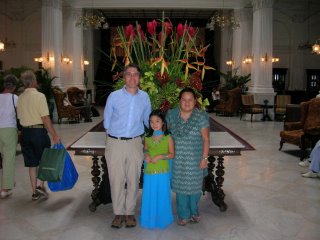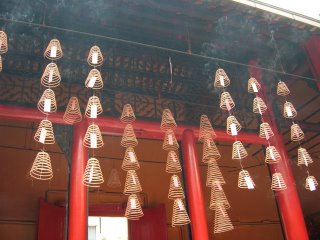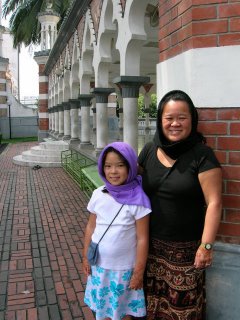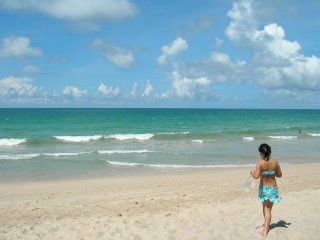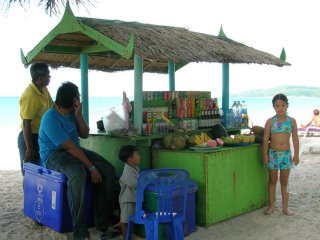One of our favorite TV shows is
The Amazing Race. Our friends Ronda and Mark got us hooked on it, and it’s really great for vagabonds like ourselves to watch people race around the world doing all sorts of interesting challenges and wondering all the while, as they fall into rivers and get lost, how can they be so
stupid?
Well, add in some jet lag, extreme weather, an unfamiliar language and hard physical challenges and the most hardy traveler can be humbled, which sums up our own adventures yesterday in northern Thailand.
The morning started bright and early for us, when we met up with Emma, a British expat from Singapore who we’d met the previous day on the bus to the Maesa elephant camp, and our tour guide Ay. The goal: to ride an elephant. We had all agreed that the previous day’s excursion was too tame and touristy, as we chafed at the wearing the groove that is the beaten path. So to have a little more adventure we signed up for what we thought was a pretty straightforward
tour: ride an elephant, hike to a village, raft a river, the stuff of every traveler’s dream in Thailand.
After an hour’s ride south of Chiang Mai in a van packed with our guide, the driver, a French couple, a Canadian and the four of us, we were dropped off at a turnoff on the edge of a narrow twisty road. This is where we were to get out and hike for 45 minutes to a Hmong village. It didn’t sound too bad on paper, but this was a steep hike--up a muddy mountain trail no less--in Thailand’s sad excuse for fall weather, with the mercury well over 30 deg C (in the mid-90’s Fahrenheit). At one point we had to cross a hanging bridge suspended by a couple of cables and slats of bamboo, one that would give
Indiana Jones reason to pause, and there was no comfort seeing the remains of the previous bridge dangling from the neighboring trees.
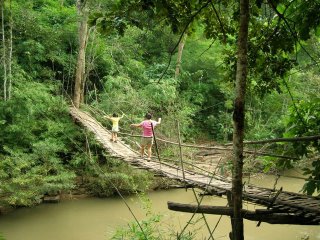
I asked our guide if we would see any animals.
“Just birds and snakes” was her reply.
“Oh god,” I told her. “I HATE snakes!”
“But Thais thinks it’s good luck to see a snake,” she insisted.
“I’ve already seen a snake here in Thailand,” I told her, “and so I think I have enough luck, so please, scare the snakes away, okay?”
Somehow I think she didn’t seem convinced, and I thought I could hear her calling out for the snakes under her breath.
When we’d signed up for this trip the previous day, I had asked the woman registering us if there were snakes out there. Yeah, I know, dumb question, but I had to open my mouth.
“Oh, no snakey out there,” she said. “And if you do see a snake your guide will eat them.”
I’m wondering if she shared that information with Ay.
We managed to dodge the snakes, and 45 minutes later we stumbled into the village huffing and puffing and practically passing out from the heat and the steep climb only to find ourselves in a small clearing with 6 to 9 “houses.” We had climbed up here for this? Sadly, most of the people between the ages of 10 and 40 were gone--it seems they have real jobs in the city--and the only ones left were tiny babies and old women, needlepointing traditional Hmong designs and hawking them to the farang tourists. The chickens running around under our feet outnumbered the villagers, and I was wondering whether it was possible to pick up bird flu from the dirt blowing around. After buying a couple hand-embroidered pillow cases, we hiked back to the main road to meet the elephants.
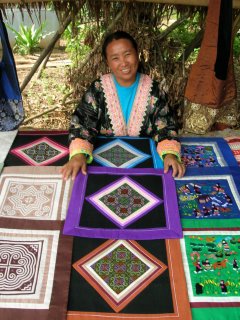
At the elephant camp we climbed up a ladder to a rickety platform and hopped on our elephant, who had a bit of a motivation issue. She was recalcitrant and seemed to view us as a burden that kept her from what she really wanted to do: eat, drink, scratch her bum, and create more dung for the paper manufacturing industry. It was an hour-long slog through mud as the driver kept knocking her on the head to get her to move. I was tempted to tell him to knock it off, but since he could speak no English, what would come out would only be unintelligible rantings from yet another tourist. Plus I didn’t want to be stranded on her for hours, and I think the only way to get back to the platform was for him to knock her. Elephants are really amazing animals; they are so huge, yet incredibly graceful. Their weight is distributed so well on their humongous feet that they put less pressure on the ground than a human. They could also amble up and down trails steeper than the ones we’d hiked earlier, with us hanging onto the seat worrying that it would slide off or that we would slide out. The elephant ride was truly the highlight of our day.

I’m not sure what compelled us to do the raft ride. It sounded kind of fun, a lazy spin down a river, with a guide to steer the way, and it was part of the standard tour. Perhaps we should have been clued in by the guide jerry-rigging the raft to make room for the four of us, but this raft was a dud. The guide was also a dud and the trip was the most frightening thing we have done on this journey. We realize that travel entails some sorts of risks. From the moment you walk out the door, there’s always the risk of “something bad” happening, but we have felt relatively safe except for twice on this trip where we thought we might die. The first time was on the taxi ride from Lhasa to the Gongkor airport. The second was on the river.
It started bad and quickly went to worse. As the four of us stepped onto the raft, it sunk enough so that Emma, Dylan and I had water up to our waists. (Andy and the “driver”--I have to use this term loosely given his abilities--were standing.) Ay shot a picture of us. Before getting on I asked her if any of the rafts tip over.
“Oh, when the river is high they do” she said.
“And when it’s like this?” I asked.
“No, no tips. Sometimes people fall,” she replied.
“Well, that’s a relief,” I said.
“Yeah, but you have to worry about the crocodiles and snakes,” she mumbled.
“Right, you’re just trying to freak me out,” I said.
There was no reply.
There are a few things you need to know about this trip. One, we use the term raft very literally here. This was not a cute euphemism for a fully functional boat. This was literally 10 long poles of bamboo strapped together with old rubber from motor scooter tires. That’s it. No pontoons, safety belts or bars or anything that would ensure that it would float. Second, there is no such thing as a life vest here in Asia. No seatbelts in cars, no life vests on boats, and no safety caps on medicines. That would be considered a luxury. Third, I’m a really bad swimmer. Sadly, after many years and countless dollars my parents spent on swimming lessons, I can still only do a doggie paddle.
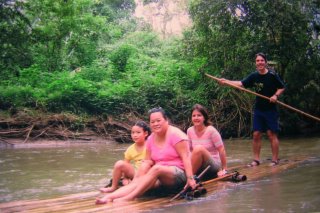
The ride was to last an hour, but within minutes I knew this was a bad idea. As the guide pushed the raft downstream with his bamboo pole, we started to tip. Dylan sat to my right, and we tipped in that direction. I was hanging on with her for dear life, but I knew my grip wouldn’t be enough to keep her on if the whole thing went over. She was submerged to her armpits and promptly told me she hated this. The raft righted, but we were still a on a raft that was floating under the water and not on top. For twenty minutes, we were like this. The raft would rock to one side, Andy and the driver would shift their weight and Dylan and I kept getting dipped in. Floating by elephants grazing at the side of the river didn’t make the trip any better, and it quickly got worse.
In front of us a raft of Thai kids had lost one of their poles and were not navigating down the river well. They had no driver and were clearly inexperienced and it would be no time at all before they were dumped in the water. It was a freak occurrence, but we could see their raft spin around and block the part of the river for which we were heading. We crashed into them, and that’s when Dylan started screaming. The driver jumped into the water and held onto the raft so it wouldn’t take us further and a couple of the kids helped us off it to the shore. Dylan was terrified, sobbing and wailing while I was trying to get her to calm down and Andy was yelling at me to get off the raft, NOW!!! Emma was able to get off first and help us off. Finally they got our raft over the lodged one, and got us back on. Dylan and I were clinging to each other, freezing cold, terrified that the raft would continue to tip and eventually overturn, and cursing the fact that we were on this ride.
At one point we had to portage, while the driver took the raft over some small falls. Dylan didn’t want to get back on, and neither did I, but there was no other way out. We didn’t have shoes on, so climbing up over the bank and however far we would have to walk to get to the road did not seem feasible. We continued down and passed a group of Thais who kept yelling to us that the ride was about 5 minutes from being done. Never trust a local when they tell you it’s only 5 minutes: this ride was going on for another half hour. But soon we saw our guide happily snapping pictures of us as we went by.
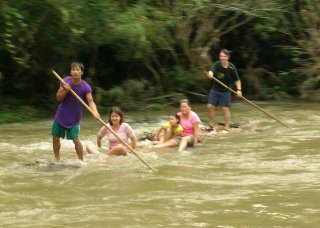
If you look at the picture Ay took, you can see Dylan sobbing, Emma muttering about how bloody inconvenient this was that they gave us such a bad raft and me yelling, “We want off. Get us off this goddamn raft NOW!!!” Ay finally heard us and yelled to the driver who pushed the raft over to the side. Crying and quite shaken we stumbled up to the van and told Ay that this trip was terrible, dangerous and foolhardy. We shared our adventures with the others (I’m not sure how much the French couple understood), and the Canadian, a guy who seems used to traveling rough, said that he thought he too had signed up for a fun lazy trip down the river, but that in his opinion the whole thing kind of sucked. Guess he didn’t have the best time on his raft either.
While on the river I was mostly terrified and in survival mode--just get us out of here alive. But after coming through it, I realized how stupid we were to even risk taking Dylan on it. She could have fallen off, I could have lost my grip, she could have hit her head on the rocks or worse, drown. I’m not sure what we were thinking, or if we were thinking at all, but am thanking the gods above that we made it through.
Later that night, after we had cleaned up, we joined Emma for dinner and drinks, shaking our heads over the entire folly of the river trip, and congratulating ourselves for surviving.

An interesting footnote: Before leaving Portland, I asked my friend Ruby who’s psychic what the trip would hold in store for us. She said that it would be wonderful, that we would be coming back changed for the better, and that it would be the most incredible thing that we would do in our life. She personally and psychically encouraged me, yet had a couple of warnings. Ruby had said “Your time in Thailand will be OK, except watch out for rivers.” All right Ruby, we’re listening!



